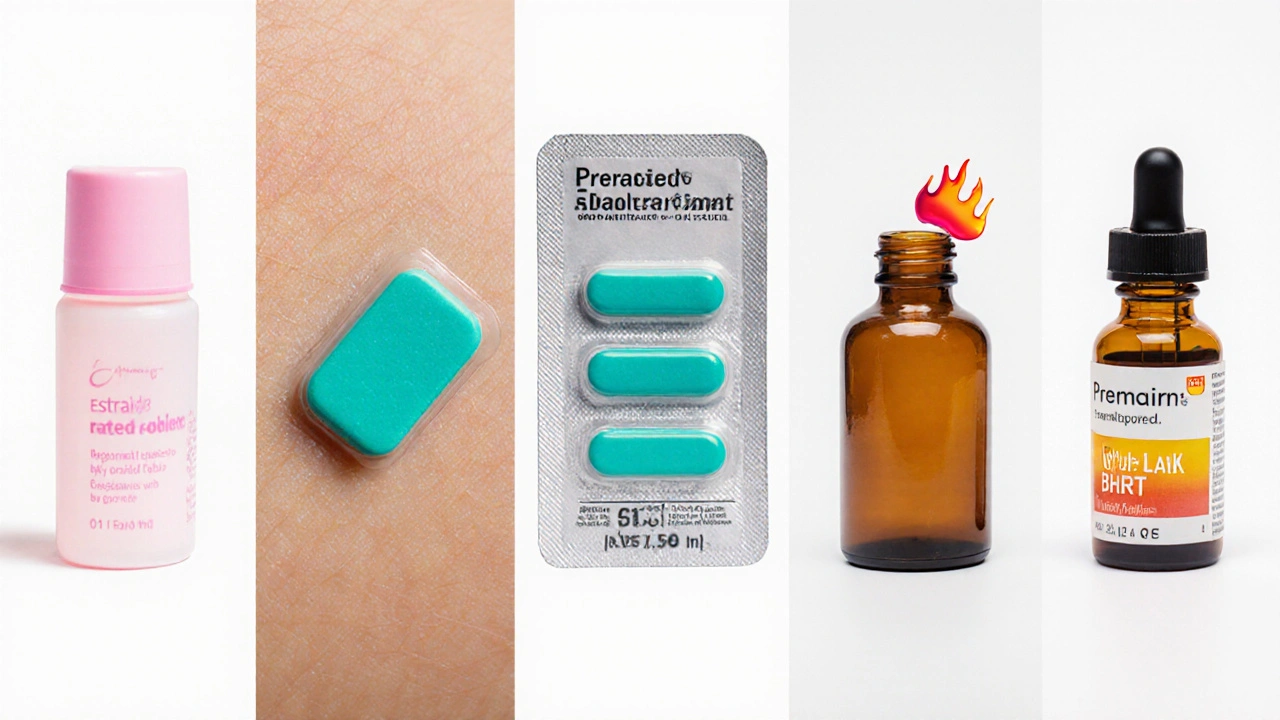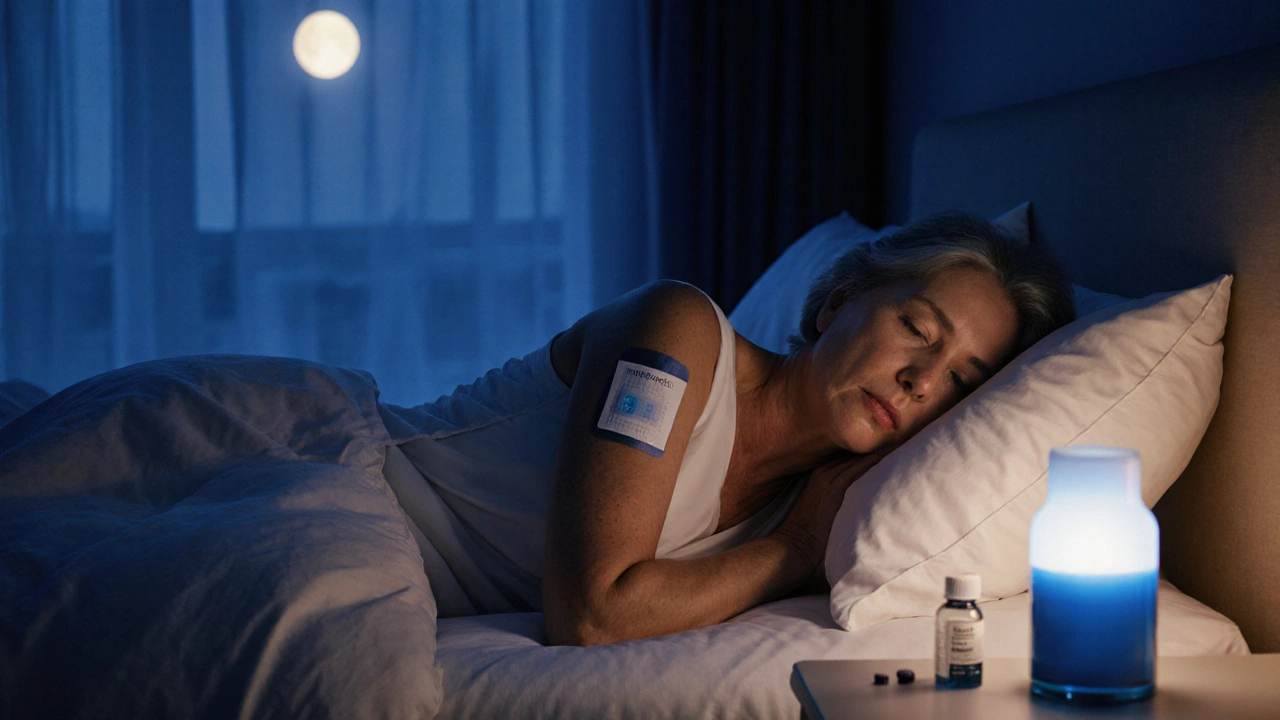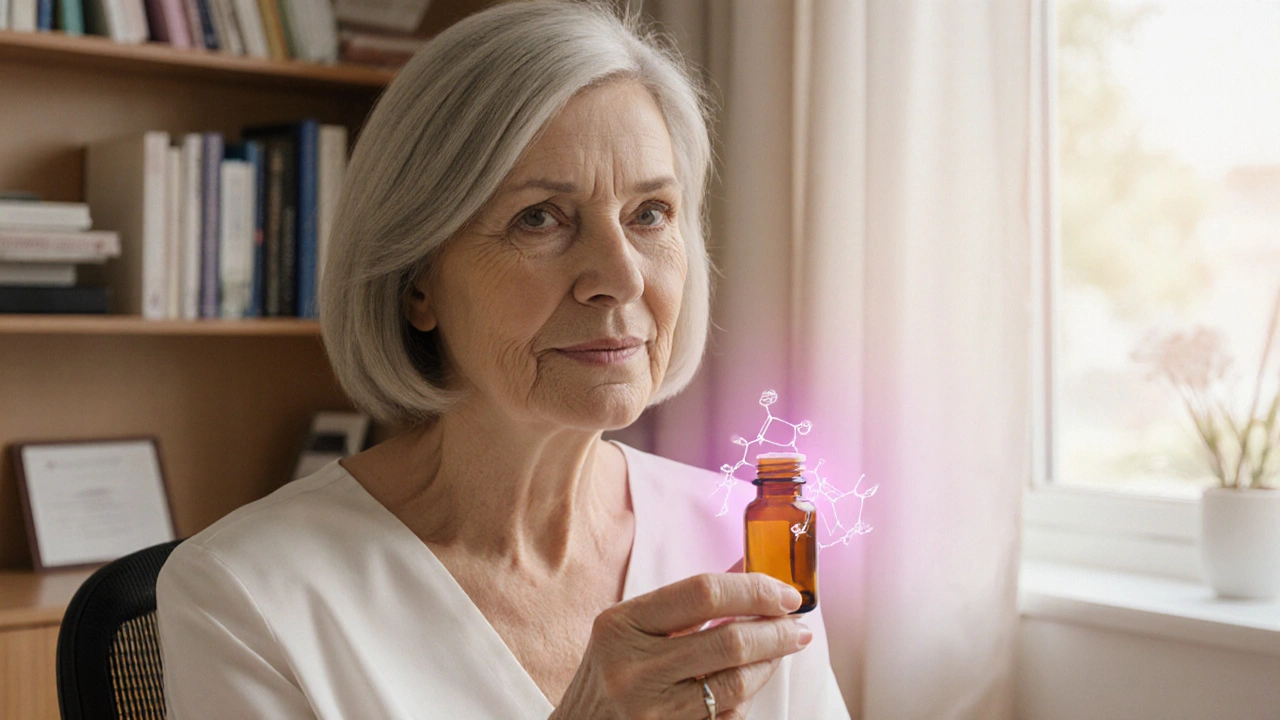Hormone Therapy Decision Guide
Find Your Best Hormone Therapy Option
Answer a few questions to get a personalized recommendation based on your unique situation.
Quick Takeaways
- Estriol is a weak estrogen that works best for mild menopausal symptoms and vaginal health.
- Estradiol delivers stronger systemic relief but carries higher risk of blood clotting.
- Conjugated equine estrogens (Premarin) are plant‑derived and useful for severe hot flashes, yet they are less bioidentical.
- Bioidentical hormone replacement therapy (BHRT) blends can be customized but need careful monitoring.
- Choosing the right option depends on symptom severity, health history, and how you prefer to take the hormone.
When you start Googling "estriol vs alternatives," the goal is simple: figure out which estrogen product gives you relief without unwanted side effects. Below we break down the science, compare the major players, and give you a practical decision framework.
When talking about hormonal menopause support, Estriol is a naturally occurring estrogen that is produced in small amounts by the placenta and later by the adrenal glands. It is often labeled a "weak" estrogen because its binding affinity to estrogen receptors (ER‑α and ER‑β) is roughly 1‑2% of estradiol, the primary estrogen in pre‑menopausal women. This low potency translates to milder systemic effects and a stronger focus on local tissue-especially the vaginal mucosa.
What Is Estriol?
Estriol belongs to the estrogen family, together with estradiol and estrone. While estradiol drives most classic estrogen actions (bone density, cardiovascular health, mood), estriol’s role is more nuanced. In clinical practice, doctors prescribe estriol mainly for:
- Vaginal dryness and atrophic changes.
- Mild to moderate hot flashes that don’t respond well to low‑dose progesterone.
- Women with a history of estrogen‑sensitive cancers who need a gentler option.
Because estriol is metabolized quickly-its half‑life is about 12hours-it rarely builds up in the bloodstream, keeping systemic exposure low.
How Estriol Works
Estriol engages both estrogen receptors, but it shows a slight preference for ER‑β, which is abundant in the uterus, ovary, and immune cells. This bias means estriol can modulate inflammation and improve vaginal epithelial health without strongly stimulating the uterus-a key reason it’s considered safer for women with a uterus who cannot take progestin.
Key pharmacokinetic facts (source: 2024 Endocrine Society review):
- Oral bioavailability ≈30%; transdermal patches boost it to 45%.
- Metabolized primarily in the liver via sulfation, producing estriol‑3‑sulfate, which is excreted in urine.
- Peak plasma concentrations occur 1-2hours after oral dosing.

Common Alternatives to Estriol
Below are the most frequently prescribed estrogen options, each with its own risk‑benefit profile.
Estradiol is the dominant estrogen before menopause, delivering robust relief for hot flashes, mood swings, and bone loss. It can be taken orally, transdermally, or as a vaginal cream.
Conjugated Equine Estrogens (Premarin) are derived from pregnant mares’ urine. The mixture contains several estrogenic compounds (mainly estrone sulfate) and is typically prescribed for severe vasomotor symptoms.
Bioidentical Hormone Replacement Therapy (BHRT) combines estradiol, estriol, and often progesterone in ratios tailored to the individual. Compounded formulas can be customized but lack FDA‑approved standardization.
Progesterone is not an estrogen but is paired with estrogen in women with an intact uterus to prevent endometrial hyperplasia. Micronized oral progesterone mirrors natural luteal phase levels.
Head‑to‑Head Comparison
| Attribute | Estriol | Estradiol | Premarin (CEEs) | BHRT Blend |
|---|---|---|---|---|
| Potency (relative to estradiol) | 1‑2% | 100% | ≈50‑60% | Variable (custom ratios) |
| Primary Use | Vaginal atrophy, mild vasomotor | Severe hot flashes, bone density | Severe vasomotor, urogenital | Individualized symptom profile |
| Route Options | Oral, vaginal, topical | Oral, patch, gel, vaginal | Oral, vaginal | Oral, topical, injection (compounded) |
| Half‑life | ≈12h | ≈13h (oral) | ≈24h (oral) | Depends on formulation |
| Risk of VTE (blood clot) | Low | Moderate‑high | High | Depends on estradiol content |
| Endometrial safety (no progestin needed?) | Generally safe | Requires progestin if uterus present | Requires progestin | Depends on estrogen mix |
| Cost (US 2025) | $30‑$60/month | $25‑$80/month | $40‑$100/month | $80‑$200/month (compounded) |
How to Pick the Right Option
Think of hormone choice like picking a gym program: you match intensity to your goals and current health. Use this three‑step checklist:
- Assess symptom severity. Mild dryness? Try estriol alone. Frequent hot flashes? Consider estradiol or a Premarin trial.
- Review medical history. History of blood clots, stroke, or estrogen‑sensitive cancer pushes you toward low‑potency estriol or non‑oral routes.
- Factor in lifestyle. If you dislike daily pills, a transdermal patch (estradiol) or vaginal cream (estriol) may improve adherence.
When you combine estriol with a low dose of estradiol in a BHRT blend, you often get the best of both worlds: systemic relief plus vaginal protection, while keeping overall estrogen exposure modest.

Safety & Side‑Effect Snapshot
All estrogen therapies share a core set of possible adverse events, but the likelihood varies with potency and route.
| Side Effect | Estriol | Estradiol | Premarin |
|---|---|---|---|
| Breast tenderness | Rare | Common | Common |
| Headache | Occasional | Frequent | Frequent |
| Blood clot risk | Low | Moderate‑high | High |
| Endometrial thickening | Minimal | Requires progestin | Requires progestin |
| Vaginal irritation | Possible with creams | Low | Low |
Monitoring guidelines (2025 North American Menopause Society):
- Baseline mammogram and pelvic ultrasound before starting any estrogen.
- Check lipid panel and liver enzymes after 3months.
- Re‑evaluate symptom control and side‑effects every 6months.
Real‑World Scenarios
Case 1 - Jane, 52, mild dryness. She trialed a low‑dose estriol vaginal tablet (0.5mg) and reported 80% improvement in lubrication without any breast tenderness. No progestin needed.
Case 2 - Maria, 58, severe hot flashes. After a 12‑week trial of estradiol transdermal patch (0.025mg), her night sweats dropped from 6times/night to 1. She added micronized progesterone 200mg nightly for endometrial protection.
Case 3 - Linda, 55, history of deep‑vein thrombosis. Her physician opted for estriol oral 1mg twice daily, combined with a vaginal moisturizer. She achieved symptom relief while keeping clot risk low.
Bottom Line
If you need a gentle, locally focused estrogen, estriol is the go‑to. For broader systemic benefits, estradiol wins-but you must balance that with higher clot and breast‑tissue risk. Premarin remains a solid choice for women who respond poorly to other agents, yet its non‑bioidentical nature and clot profile make it a second‑line option for many. Custom BHRT blends let you fine‑tune the mix, but they demand regular lab checks.
Think of your hormone plan as a living prescription: start low, track outcomes, and adjust as your body changes.
Frequently Asked Questions
Can I use estriol if I still have my uterus?
Yes. Estriol’s weak estrogenic activity usually doesn’t overstimulate the endometrium, so many clinicians prescribe it without adding progestin. However, a yearly ultrasound is still recommended to rule out unexpected thickening.
Is estriol safe for women with a history of breast cancer?
Because estriol binds weakly to estrogen receptors, studies up to 2024 show no increase in recurrence risk when used at low doses for symptom control. Still, discuss any hormone plan with your oncologist.
How does the cost of estriol compare to other options?
Estriol generally costs $30‑$60 per month in the U.S., which is comparable to generic estradiol and cheaper than compounded BHRT blends that can exceed $150 per month.
Can I switch from estradiol to estriol without a washout period?
Most doctors recommend tapering off estradiol over 2‑4 weeks before starting estriol to avoid abrupt hormone fluctuations. Your provider can create a step‑down schedule.
Do I need to take progesterone with estriol?
Generally no, because estriol’s low potency poses minimal risk of endometrial overgrowth. If you are using a high‑dose estriol regimen, a short course of progesterone may be advised.

Krishna Chaitanya
October 12, 2025 AT 01:21Estriol swoops in like a quiet guardian for women battling the whisper of menopause it eases the dry fire without storming the whole system
diana tutaan
October 13, 2025 AT 17:58Data shows estriol’s clot risk remains low but the article omits long‑term surveillance figures it would benefit from citing recent WHI sub‑analysis
Sarah Posh
October 15, 2025 AT 10:35Many readers find starting with a low‑dose estriol patch a gentle way to test the waters it can lift comfort without overwhelming the body
James Knight
October 17, 2025 AT 03:11This guide feels like a sales brochure for pharma it throws buzzwords at you without addressing the real fear of side effects
Ajay D.j
October 18, 2025 AT 19:48In India estriol creams are often available over the counter and women use them for vaginal health alongside traditional Ayurvedic oils which can complement the therapy
Dion Campbell
October 20, 2025 AT 12:25The piece glosses over the pharmacodynamic subtleties of estrogen receptor isoforms an oversight that betrays a superficial grasp of endocrine nuance
Burl Henderson
October 22, 2025 AT 05:01When calibrating dosage consider the pharmacokinetic half‑life and the tissue‑specific receptor affinity to fine‑tune therapeutic index across the estradiol‑estriol spectrum
Leigh Ann Jones
October 23, 2025 AT 21:38Estriol's pharmacology stands out for its rapid metabolism and low systemic exposure.
Because it preferentially activates ER‑β, it contributes to mucosal health without strongly stimulating uterine lining.
Clinical trials over the past decade consistently report minimal breast tenderness in estriol cohorts.
Moreover, the adverse event profile shows a negligible increase in venous thromboembolism compared with placebo.
Patients with prior clotting history often tolerate estriol better than estradiol or conjugated equine estrogens.
When administered vaginally, estriol achieves high local concentrations while keeping serum levels low.
This route also avoids first‑pass hepatic metabolism, reducing impact on lipid panels and liver enzymes.
Manufacturers have priced estriol competitively, making it accessible for many insured and uninsured women.
Insurance formularies frequently place estriol in Tier 2, which translates to out‑of‑pocket costs well below compounded BHRT preparations.
From a quality‑of‑life perspective, many users report relief from dryness and improved sexual comfort within four weeks.
Physicians should still conduct baseline mammograms and pelvic ultrasounds, as guidelines recommend for any estrogen therapy.
Follow‑up visits every six months allow clinicians to adjust dosage based on symptom control and side‑effect monitoring.
If a patient experiences persistent hot flashes, a modest addition of estradiol can be considered under progestin protection.
Conversely, women with estrogen‑sensitive cancers may remain on estriol monotherapy while staying vigilant about tumor markers.
Overall, estriol offers a balanced compromise between efficacy and safety when personalized to the individual's risk profile.
Sarah Hoppes
October 25, 2025 AT 14:15Big pharma hides the real risks behind the estriol hype
Robert Brown
October 27, 2025 AT 06:51Estradiol is overprescribed and dangerous
Erin Smith
October 28, 2025 AT 23:28Absolutely the low‑dose start is wise it lets the body adapt gently while you monitor any changes
George Kent
October 30, 2025 AT 16:05Seriously, the United States pushes estrogen products without rigorous European oversight, which is unacceptable!!! 😡🇬🇧